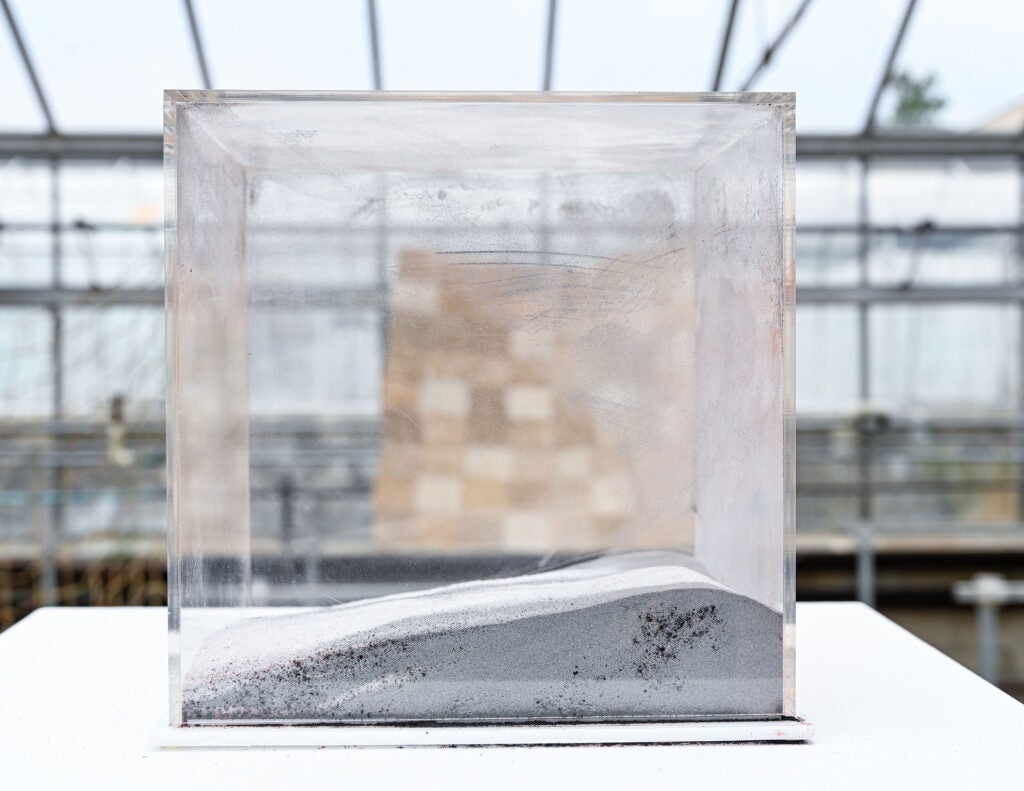KINGSTON, R.I. – Nov. 21, 2022 – Walk to the path by the Greenhouses, across from the Fine Arts Center. Find the Horridge Conservatory and cross through that warm and bright space, teeming with unique specimens. Pass by the indoor koi pond and take a right at the greenhouse’s end. Walk by College of the Environment and Life Sciences’ class spaces until you come to a sign. You’ve made your way to the newest art exhibit at the University of Rhode Island.
“Some Food We Could Not Eat” is installed in a URI greenhouse, both for purposes practical (the Fine Arts building is undergoing renovation) and aesthetic. Gallery Director Rebecca Levitan started at URI last year, coming here with a goal of bringing art to people who might not usually encounter it. In this exhibition, she hoped to venture into new, not necessarily “white gallery wall,” spaces on campus. So the secret-garden feel to one’s path to the greenhouse is part of the viewer’s artistic journey.

With a gallery exhibit about food as art, what better place to travel or view it than through the University’s working greenhouses?
The exhibit is open 8 a.m. through 4 p.m. this fall, Monday through Friday (excluding holidays), running in conjunction with the University’s 2022 Honors Colloquium, “Just Good Food,” which focuses on food systems.
Levitan knew she wanted to find artists working with food in novel, conceptual ways. “I didn’t want to just have paintings of food on the wall. I wanted to find artists who made food an integral part of their work.”
Jennie Maydew, an educator from Brooklyn, incorporated wild plants and food waste gathered for the exhibit; from onion skins to coffee filters. Her work represents the ephemeral, indeed compostable, nature of her subject matter. She also created live anthotype prints derived from pigments found in certain plants and flowers to further showcase the perishable nature of food and textiles.
Zoe Scruggs, a multidisciplinary artist and farmer from Delaware, contributed three prints to the show. A descendant of sharecroppers, much of Scruggs’ work is inspired by farmers, environmental justice activists and cultural workers, grappling with the ways Black American trauma is rooted in relationship to the land.
Providence-based installation artist Kamari Carter created an acrylic cube display that is soothing to look at — until you realize that the cube is filled with 304 packets of grape powder, a serialized representation of the Peoples Temple agricultural project in Guyana and its infamous ending in 1978 when members committed suicide using the flavored drink. Carter began by thinking about food in terms of tradition and culture and considering ways to present it in a more abstract way, representing the body as a temple.
“I wanted to focus on the idea of nourishment turned around,” he said. “There’s a tension in the environment for this exhibit but it works.” Carter will next bring his work to MASS MoCA (Massachusetts Museum of Contemporary Art) in January.
“I think what’s key in my work is that it is ongoing. I hope the work is not so fixed for the artist or the viewer that there can’t be a conversation. We can take treacherous things and situations and still talk about them, even things that are difficult to talk about.”
The greenhouse setting for the exhibit only serves to amplify the power of these displays and the questions they elicit.
“Art doesn’t have to happen in a traditional gallery space,” asserts Levitan, “or on a hallway in an academic building. We hope more people visit before the show closes in December.” The exhibit is a little off the beaten path but very accessible, she notes, as many students walk by the greenhouses on the path from the Fine Arts parking lot.
“As a school, we can expose students to more challenging and conceptual work,” she said. “That is part of the gallery’s mission; we can explore what conceptual art means and provide access to something you’d normally only see in a big city.”
The exhibit will be up through Dec. 13. Visitors to campus can find parking details here.

